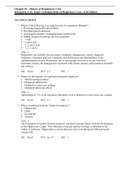Samenvatting
Summary FOSSS + An Invitation to Environmental Sociology, ISBN: 9781506301068 Foundations of Social Sciences for Sustainability
- Instelling
- Universiteit Utrecht (UU)
Summary FOSSS including the articles needed for the lectures. The summary is made in a table. On the left side, there are themes and concepts, on the right side definitions. The concepts are clustered per lecture, article, etcetera. I scored an 8.9 using this summary, thereby scoring the highest gr...
[Meer zien]














